CBSE Class 8 Maths – MCQ and Online Tests – Unit 5 – Data Handling
Every year CBSE students attend Annual Assessment exams for 6,7,8,9,11th standards. These exams are very competitive to all the students. So our website provides online tests for all the 6,7,8,9,11th standards’ subjects. These tests are also very effective and useful for those who preparing for any competitive exams like Olympiad etc. It can boost their preparation level and confidence level by attempting these chapter wise online tests.
These online tests are based on latest CBSE syllabus. While attempting these, our students can identify their weak lessons and continuously practice those lessons for attaining high marks. It also helps to revise the NCERT textbooks thoroughly
CBSE Class 8 Maths – MCQ and Online Tests – Unit 5 – Data Handling
I. Observe the following bar graph carefully and answer the following questions :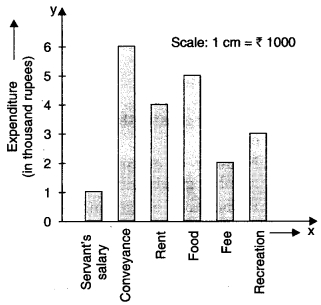
Question 1.
Rs 5000 is the expenditure done on
(a) rent
(b) food
(c) fee
(d) recreation.
Answer
Answer: (b)
Hint:
\(\frac{5000}{1000}\) = 5 cm is the height of the bar corresponding to food.
Question 2.
On which item has the minimum expenditure been done ?
(a) Servant’s salary
(b) Food
(c) Rent
(d) Conveyance.
Answer
Answer: (a)
Hint:
The height of the bar corresponding to servant’s salary is minimum.
Question 3.
What is the expenditure done on food ?
(a) Rs 1000
(b) Rs 2000
(c) Rs 3000
(d) Rs 5000.
Answer
Answer: (d)
Hint:
Expenditure done on food = 5 × 1000
= Rs 5000.
Question 4.
On which item has the maximum expenditure been done ?
(a) Conveyance
(b) Rent
(c) Fee
(d) Servant’s salary.
Answer
Answer: (a)
Hint:
The height of the bar corresponding to conveyance is the maximum.
Question 5.
What is the difference of expenditures done on conveyance and rent ?
(a) Rs 1000
(b) Rs 2000
(c) Rs 3000
(d) Rs 4000.
Answer
Answer: (b)
Hint:
Expenditure done on conveyance
= 6 × 1000 = Rs 6000
Expenditure done on rent = 4 × 1000
= Rs 4000
? Difference = Rs 6000 – Rs 4000
= Rs 2000.
Question 6.
Rs 6000 is the expenditure done on
(a) fee
(b) rent
(c) conveyance
(d) food.
Answer
Answer: (c)
Hint:
\(\frac{6000}{1000}\) = 6 cm is the height of the bar corresponding to conveyance.
Question 7.
How much expenditure has been done in all ?
(a) Rs 21000
(b) Rs 18000
(c) Rs 15000
(d) Rs 20000.
Answer
Answer: (a)
Hint:
Total expenditure
= (1 + 6 + 4 + 5 + 2 + 3) × 1000 = Rs 21000
II. Observe the following bar graph carefully and answer the following questions :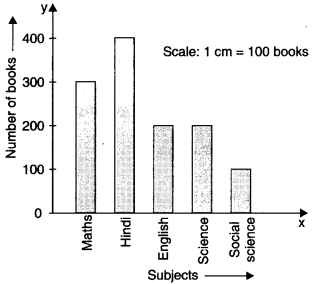
Question 1.
Of which subject are there the maximum books ?
(a) Hindi
(b) English
(c) Maths
(d) Science.
Answer
Answer: (a)
Hint:
The height of the bar corresponding to Hindi is maximum.
Question 2.
Of which subject are there the minimum books ?
(a) Social Science
(b) Hindi
(c) English
(d) Science.
Answer
Answer: (a)
Hint:
The height of the bar corresponding to Social Science is minimum.
Question 3.
How many books are there of the subject whose books are maximum ?
(a) 100
(b) 200
(c) 300
(d) 400.
Answer
Answer: (d)
Hint:
Hindi ? 400.
Question 4.
How many books are there of the subject whose books are minimum ?
(a) 100
(b) 200
(c) 300
(d) 400.
Answer
Answer: (c)
Hint:
Social Science ? 100.
Question 5.
300 books are of the subject
(a) Maths
(b) English
(c) Hindi
(d) Science.
Answer
Answer: (a)
Hint:
300 ? Maths.
Question 6.
Which two subjects have the same number of books ?
(a) Maths and Hindi
(b) Hindi and English
(c) English and Science
(d) Science and Social Science.
Answer
Answer: (c)
Hint:
English ? 200
Science ? 200
Question 7.
The difference of the number of books of English and Science is
(a) 200
(b) 100
(c) 400
(d) 0.
Answer
Answer: (d)
Hint:
200 – 200 = 0.
Question 8.
The difference of the number of books of Hindi and Social Science is
(a) 200
(b) 300
(c) 400
(d) 100.
Answer
Answer: (b)
Hint:
400 – 100 = 300.
Question 9.
The total number of books is
(a) 1200
(b) 1400
(c) 1600
(d) 1800.
Answer
Answer: (a)
Hint:
300 + 400 + 200 + 200 + 100 = 1200.
Question 10.
The total of the number of books of English and Science is
(a) 200
(b) 100
(c) 400
(d) 0.
Answer
Answer: (c)
Hint:
200 + 200 = 400.
III. Study the following frequency distribution table and answer the questions given below :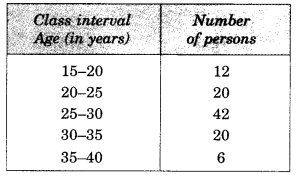
Question 1.
Which two classes have the same frequency ?
(?) 15-20 and 35-40
(b) 20-25 and 30-35
(c) 15-20 and 30-35
(d) 20-25 and 25-30.
Answer
Answer: (b)
Hint:
Frequency of class 20-25 = Frequency of class 30-35 = 20.
Question 2.
Which class has the highest frequency ?
(a) 15-20
(b)20-25
(c) 25-30
(d) 35-40.
Answer
Answer: (c)
Hint:
Highest frequency = 42 ? 25 – 30.
Question 3.
The difference between the frequencies of the class intervals 20-25 and 30-35 is
(a) 0
(b) 10
(c) 20
(d) 5.
Answer
Answer: (a)
Hint:
Frequency of class 20-25 = 20.
Frequency of class 30-35 = 20
? Difference = 20-20 = 0.
Question 4.
Which class has the lowest frequency ?
(a) 35-40
(b)30-35
(c) 15-20
(d) 25-30.
Answer
Answer: (a)
Hint:
Lowest frequency = 6 ? 35 – 40.
Question 5.
What is the size of the class intervals ?
(a) 5
(b) 10
(c) 15
(d) 20.
Answer
Answer: (a)
Hint:
Size = 20 – 15 = 5.
Question 6.
What is the upper limit of the class interval 25-30 ?
(a) 20
(b)25
(c) 30
(d) 35.
Answer
Answer: (c)
Question 7.
What is the lower limit of the class interval 35-40 ?
(a) 20
(b) 25
(c) 30
(d) 35.
Answer
Answer: (d)
IV. Study the following frequency distribution table and answer the questions given below :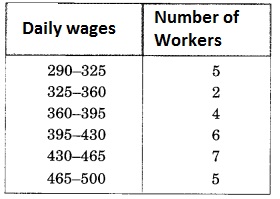
Question 1.
The frequency of the third class is
(a) 5
(b) 4
(c) 2
(d) 7.
Answer
Answer: (b)
Hint:
Third class is 360 – 395.
Question 2.
The lower limit of the sixth class is
(a) 395
(b) 430
(c) 465
(d) 360.
Answer
Answer: (c)
Hint:
Sixth class is 465 – 500.
Question 3.
The number of workers getting daily wages 395-430 (in ?) is
(a) 4
(b) 5
(c) 6
(d) 7.
Answer
Answer: (c)
Hint:
Frequency of class 395 – 430 is 6.
Question 4.
The size of the class intervals is
(a) 25
(b) 30
(c) 40
(d) 35.
Answer
Answer: (d)
Hint:
Fourth class is 395-430.
Question 5.
The upper limit of the fourth class is
(a) 430
(b) 395
(c) 465
(d) 500.
Answer
Answer: (a)
Hint:
Size = 325 – 290 = 35.
Question 6.
Which two classes have the same frequency ?
(a) 290-325 and 465-500
(b) 290-325 and 325-360
(c) 430-465 and 465-500
(d) 325-360 and 360-395.
Answer
Answer: (a)
Hint:
Frequency of class 290-325
= Frequency of class 465-500 = 5.
Question 7.
The class with highest frequency is
(a) 430-465
(b) 465-500
(c) 395-430
(d) 290-325.
Answer
Answer: (a)
Hint:
Highest frequency = 7 ? 430-465.
Question 8.
The class with lowest frequency is
(a) 325-360
(b) 360-395
(c) 465-500
(d) 395-430.
Answer
Answer: (a)
Hint:
Lowest frequency = 2 ? 325-360.
Question 9.
The number of workers getting wages ? 395 and above is
(a) 18
(b) 24
(c) 12
(d) 28.
Answer
Answer: (a)
Hint:
Required number = 6 + 7 + 5 = 18.
Question 10.
The number of workers getting wages below ? 360 is
(a) 7
(b) 6
(c) 5
(d) 4.
Answer
Answer: (a)
Hint:
Required number = 5 + 2 = 7.
Question 11.
The total number of workers is
(a) 29
(b) 22
(c) 28
(d) 21.
Answer
Answer: (a)
Hint:
Required number = 5 + 2 + 4 + 6 + 7 + 5
= 29.
V. Observe the histogram and answer the questions given below :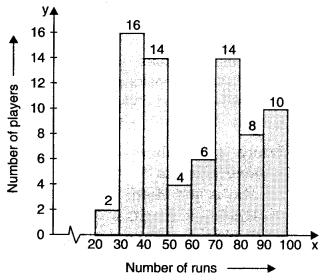
Question 1.
Which group contains maximum players ?
(a) 20-30
(b) 30-40
(c) 40-50
(d) 70-80.
Answer
Answer: (b)
Hint:
Maximum frequency = 16 ? 30-40.
Question 2.
Which group has minimum players ?
(a) 20-30
(b) 50-60
(c) 60-70
(d) 30-40.
Answer
Answer: (a)
Hint:
Minimum frequency = 2 ? 20-30.
Question 3.
Which two groups have the same number of players ?
(a) 30-40 and 40-50
(b) 20-30 and 30-40
(c) 40-50 and 70-80
(d) 80-90 and 90-100.
Answer
Answer: (c)
Hint:
Frequency of group 40-50 = 14
= Frequency of group 70-80.
Question 4.
How many players make runs 80 and above ?
(a) 2
(b) 8
(c) 10
(d) 18.
Answer
Answer: (d)
Hint:
Required number = 8 + 10 = 18.
Question 5.
How many players make runs less than 40?
(a) 8
(b) 2
(c) 18
(d) 10.
Answer
Answer: (c)
Hint:
Required number = 2 + 16 = 18.
Question 6.
How many players make runs 50 to less than 60 ?
(a) 1
(b) 2
(c) 3
(d) 4
Answer
Answer: (d)
Hint:
Required number
= Frequency of group 50-60 = 4.
Question 7.
The total number of players making runs 20 and more is
(a) 74
(b) 64
(c) 84
(d) 54.
Answer
Answer: (a)
Hint:
Required number
= 2 + 16 + 14 + 4 + 6 + 14 + 8 + 10 = 74.
VI. Observe the histogram and answer the questions given below :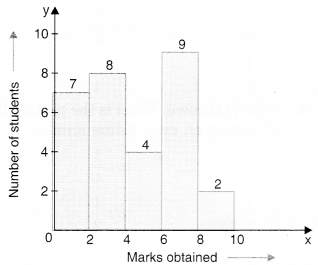
Question 1.
The number of students getting marks 4 to less than 6 is
(a) 2
(b) 4
(c) 6
(d) 8.
Answer
Answer: (b)
Hint:
Required number
= Frequency of class (4 – 6) = 4.
Question 2.
Which groups contain the maximum number of students ?
(a) 2-4
(b) 4-6
(c) 6-8
(d) 8-10.
Answer
Answer: (c)
Hint:
Maximum number of students
= 9 ? 6 – 8.
Question 3.
The number of students getting marks in the groups 4-6 or 8-10 is
(a) 2
(b) 4
(c) 6
(d) 8.
Answer
Answer: (c)
Hint:
Required number = 4 + 2 = 6.
Question 4.
Which group contains the minimum number of students ?
(a) 0-2
(b) 2-4
(c) 6-8
(d) 8-10.
Answer
Answer: (d)
Hint:
Minimum number of students
= 2 ? 8 -10.
Question 5.
The total number of students is
(a) 10
(b) 20
(c) 25
(d) 30.
Answer
Answer: (d)
Hint:
Total number of students
= 7 + 8 + 4 + 9 + 2 = 30.
Question 6.
The number of students getting marks 6 and above is
(a) 11
(b) 10
(c) 12
(d) 9.
Answer
Answer: (a)
Hint:
Required number = 9 + 2 = 11.
Question 7.
The number of students getting marks less than 4 is
(a) 10
(b) 15
(c) 7
(d) 8
Answer
Answer: (b)
Hint:
Required number = 7 + 8 = 15.
Question 8.
The number of students getting marks 6-8 is greater than the number of students getting marks 2-4 by
(a) 1
(b) 2
(c) 3
(d) 4.
Answer
Answer: (a)
Hint:
Required difference = 9 – 8 = 1.
VII. Observe the pie chart given below and answer the following questions: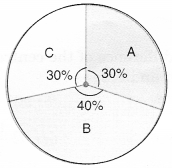
Question 1.
What is the difference between the central angles for sector B and sector C ?
(a) 36°
(b) 72°
(c) 9°
(d) 81°.
Answer
Answer: (a)
Hint:
144° – 108° = 36°.
Question 2.
The central angle for sector A is
(a) 108°
(b) 144°
(c) 72°
(d) 150°.
Answer
Answer: (a)
Hint:
Central angle for sector A
= \(\frac{30}{100}\) × 360° = 108°.
Question 3.
The central angle for sector B is
(a) 108°
(b) 144°
(c) 72°
(d) 120°.
Answer
Answer: (b)
Hint:
Central angle for sector B
= \(\frac{40}{100}\) × 360° = 144°.
Question 4.
Which sector has the greatest angle ?
(a) A
(b) B
(c) C
(d) None of these.
Answer
Answer: (b)
Hint:
Greatest percentage = 40% ? B.
VII. Observe the pie chart and answer the following questions :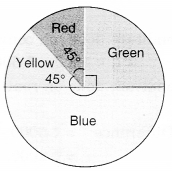
Question 1.
The difference of the central angles for green and blue is
(a) 45°
(b) 90°
(c) 180°
(d) 22\(\frac{1°}{2}\)
Answer
Answer: (b)
Hint:
Central angle for blue = 180°
Central angle for green = 90°
? Difference = 180° – 90° = 90°.
Question 2.
Which colour has the greatest central angle ?
(a) Red
(b) Yellow
(c) Green
(d)Blue.
Answer
Answer: (d)
Hint:
Blue ? 180°.
Question 3.
Which two colours have the same central angles ?
(a) Red, yellow
(b) Red, green
(c) Yellow, green
(d) Blue, red.
Answer
Answer: (a)
Hint:
Red ? 45%
Yellow ? 45%.
Question 4.
A child has a block in the shape of a cube with one letter written on each face as shown below:![]()
The cube is thrown once. What is the probability of getting A ?
(a) \(\frac{1}{3}\)
(b) \(\frac{1}{6}\)
(c) \(\frac{1}{2}\)
(d) \(\frac{1}{4}\)
Answer
Answer: (a)
Hint:
Probability = \(\frac{2}{6}\) = \(\frac{1}{3}\)
Question 5.
A die is thrown. What is the probability of getting an even prime number ?
(a) \(\frac{1}{6}\)
(b) \(\frac{1}{4}\)
(c) \(\frac{1}{3}\)
(d) \(\frac{1}{2}\)
Answer
Answer: (a)
Hint:
Even prime number = 2
? Probability = \(\frac{1}{6}\)
Question 6.
The proportion of sector for red is
(a) \(\frac{1}{2}\)
(b) \(\frac{1}{4}\)
(c) \(\frac{1}{8}\)
(d) \(\frac{1}{3}\)
Answer
Answer: (c)
Hint:
\(\frac{45°}{360°}\) = \(\frac{1}{8}\)














0 Comments:
Post a Comment